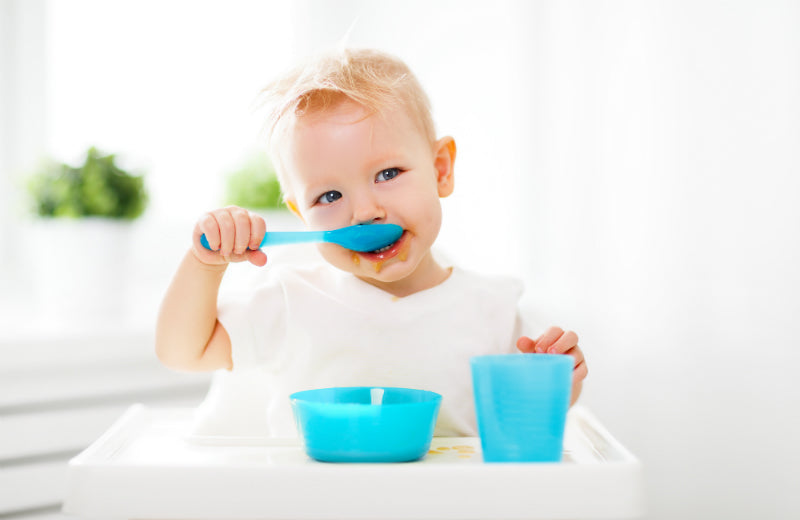" Patience and the right tableware set for success "
When children learn to eat, the time of the firstchildren's cutlerythe rightchildren's tableware, lots ofcolorful dishes and of course eternal patience. The Zwergehuus magazine will help you to get through this time of fun but also refusal.
The first complementary food
Nature has been kind to us. Babies do not have to learn how to take their mother's milk. It is an innate reflex that serves survival. This means that moms and dads don't have to worry about feeding their offspring in the first few weeks. Regardless of whether the mother is breastfeeding or giving the baby a bottle. First of all, the baby is very well supplied with formula. However, this time does not last forever. The little diaper wearer is constantly growing and thriving and from the fourth month onwards, the time for the first complementary foods begins. Of course, as parents you decide individually when the right time has come for the first baby food. After all, children develop quite differently.

The time for baby food begins from the 4th month
As soon as the first baby food is on the menu, it's time for you to start thinking about children's cutlery and crockery. A baby just four or five months old cannot yet eat from a normal spoon. Fortunately, you can choose from a range of cutlery and tableware specially designed for the little ones.
Eating meals together from six months onwards
Children need a consistent routine when it comes to mealtimes. You won't always be able to get the whole family together at the table. These days, appointments and work commitments mean that there is very little time for the whole family to get together. If it is hardly possible during the week, at least meals should be eaten together at the weekend.

Babies still need to be fed in the first few weeks
A baby must learn that it does not always have to eat alone. On the contrary. As soon as your little one is able to sit independently in a high chair, let them join you at the table every time. Even if they are not hungry. In this way, children learn that eating together is much more than just eating.
Before your little angel picks up the spoon herself, it's up to you. You feed the child for the first few meals. However, children can learn to eat at the same time.
Children's tableware - learning to eat can look fun
You have a wonderful selection of different designs when it comes to children's tableware. It has important features that are tailored to the needs of the little ones. Melamine is the material of choice for children's tableware. It is lightweight yet shatterproof and scratch-resistant. If a plate or cup is dropped, the tableware will not be damaged and you should be prepared to see plates and co. lying on the floor from time to time.
Cutlery
In addition to the crockery itself, cutlery is of course important. Unlike the classic cutlery you use, children's cutlery has an ergonomically shaped handle. Children can grip the fork or spoon better. In addition, the spoon and fork are naturally somewhat smaller. Now patience is required. When children are learning to eat, because not every spoon ends up where it should. Some food will miss its target. Therefore, it is of course advisable not to learn to eat with children on the expensive carpet. Some parents lay a cloth under the high chair. If you have tiles or laminate flooring, you don't need to worry about this.

Help your child to eat
Help your child to hold the spoon correctly and constantly encourage them to try on their own. Even if a lot of things go wrong. It is a learning process and your child will feel a little more proud each time they are allowed to take the spoon on their own. Help your child to become independent and look past the unavoidable chaos with a relaxed attitude. Looking back, time will pass so quickly that you will only remember the good moments.
Bibs
 Of course, you must not forget bibs. They protect clothes from too many stains when your baby eats alone. Take the opportunity to add a personal touch to the bibs. Embroideries such as "crumb monster", "gourmet", "milk boy" or "pea princess" are very popular. There are hardly any limits to embroidering a bib. Incidentally, it is also a good idea to have a few in reserve. The choice of motifs on cutlery and tableware for children is also really beautiful.
Of course, you must not forget bibs. They protect clothes from too many stains when your baby eats alone. Take the opportunity to add a personal touch to the bibs. Embroideries such as "crumb monster", "gourmet", "milk boy" or "pea princess" are very popular. There are hardly any limits to embroidering a bib. Incidentally, it is also a good idea to have a few in reserve. The choice of motifs on cutlery and tableware for children is also really beautiful.
After all, the eye eats too. From animals and farms to elves and vehicles. Whatever you and your child like.
We learn table manners from an early age!
Whether your child can behave properly at the table later on is largely up to you. If a baby is to learn to eat, then table manners are also part of the process. Of course, this is a learning process that requires a lot of patience and tolerance on your part. A baby can learn to eat by showing him how to hold the spoon and how to get the food onto the spoon.
Remember: As with so many things in a child's development, you play an important role model. Learning to eat is no different.
A baby learns by imitating as much as possible. Your behavior at the table will therefore shape your children. If you don't have the peace and quiet to sit at the table, but eat standing up or even at a small table in front of the TV, then it will be difficult to teach your child to sit quietly at the table and eat. This also includes setting the table appropriately and taking enough time for the actual meal.










